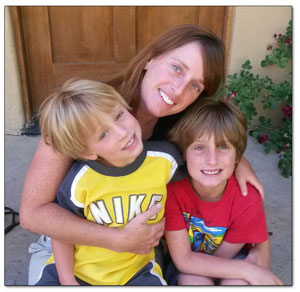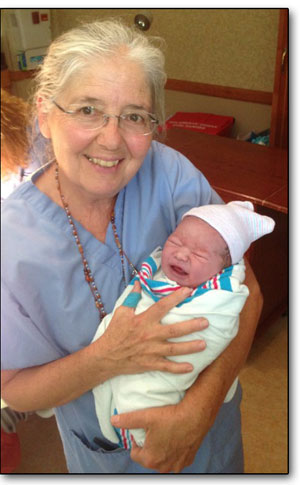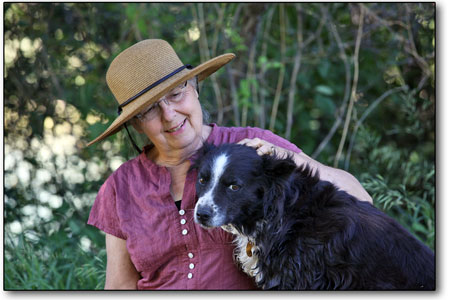|
|
A woman’s touch
After 35 years of welcoming babies to the world, midwife hangs up scrubs
by Page Buono
Mary Louise Walton is the kind of woman you’d want to have around during a birth – calm, smiling, knowledgeable, present. For the last 35 years – 17 as a nurse midwife – Walton has delivered thousands of babies and provided pre- and post-natal care for countless families in La Plata County. And come next month when Walton officially retires from Southwest Midwives, she leaves behind big shoes – and hands – to fill.
Walton was involved of the pre- and postnatal care of Jennifer Zahratka-Morrissey's two boys. Zahratka-Morrissey, who lost her mother just before the birth of her first son, said having Walton there meant the world to her.
“She was wisdom and nurturing all wrapped up in the warmest smile,” Zahratka-Morrissey said of Walton. “Not having my mom around, that kind of comfort was amazing.”
Zahratka-Morrissey, who knew she wanted a woman to deliver her children and wanted more options than a traditional OB/GYN, found Southwest Midwives to be the perfect alternative.
“I can’t imagine having my boys without them,” Zahratka-Morrissey said of her boys, now 6 and 4.
 Durango mom Jen Zahratka-Morrissey, whose sons, Shea, 4, left, and Dylan, 6, are among the thousands of kids Walton helped bring into the world./Courtesy photo |
For Walton, midwifery was a dream that made its way on and off her radar starting in the 1970s. After moving to Durango in 1976 with a degree in English – a “BA in BS” as she calls it – she decided to pursue nursing and wound up in medical and surgical nursing for three years.
She didn’t love it.
“It just wasn’t fulfilling,” Walton said.
Then, Walton got pregnant with her first child. During this time, she read two books – Spiritual Midwifery, by Ina May Gaskin, and Heart & Hands, by Elizabeth Davis. “I said, ‘Ah, this is what I want to do,’” Walton said.
But, like many new moms, Walton became engrossed in diapers and nap time while dreams of midwifery were pushed aside. However, after her second child – with encouragement from her husband – she shifted into OB nursing, a step closer to her calling. She loved it.
Still, it wasn’t until the first certified nurse midwife came to Durango in 1992 that Walton remembered her dream. She was 45 years old when she returned to school.
“I think it was good for my children to see that,” Walton said. “It’s never too old to change.”
Walton attended a two-year program at the Frontier School of Midwifery and Family Nursing, in Hyden, Ky. A master's program held inconjunction with Case Western Reserve University, it is the oldest such program in the country. “I felt like I’d finally found my place,” Walton said.
The practice that Walton started with partner, Amy Ginn, was a long time coming. The two had previously worked together as nurses – Walton as a labor and delivery nurse and Ginn in the nursery – at the old Mercy Hospital, where the Durango Library now is.
For Ginn, who also attended the Frontier School, the path to midwifery was a bit different. As the daughter of a biology teacher, she remembers looking at biology books from the age of 5. “I just loved science stuff, and I loved babies,” Ginn said.
She carried that love with her to Chicago, where she did her OB rotation during nursing school. It was the early ’80s and she remembers walking into a birth where a nurse midwife was present.
“The whole atmosphere in the room was completely different; I mean it was like the clouds parted and the sun rays came down ... It was amazing,” she says. “She made this woman feel like the most important person on the earth.”
While Ginn said she had known deep down her calling, that moment was an epiphany for her, and she knew midwifery was in her future.
For both Walton and Ginn, having and raising their own children first was a priority. The demands of midwifery do not yield well to raising a young family.
So, it wasn’t until 1999 that Walton and Ginn began their own private practice, Southwest Midwives. While their practice is located at Mercy Medical Center, they are not owned by the hospital.
“We are one of the very few midwife-owned practices in the country,” Ginn said. “Not being owned by the hospital allows us to practice midwifery.”
Because Southwest Midwives offers comprehensive women’s health care, offering birth control is an important part of their practice. If they were owned by the hospital, this would not be an option.
Additionally, running their own practice means they don’t have to subscribe to industry standards when it comes to productivity. For example, where the standard pre-natal visit is 10 minutes, Southwest Midwives doesn’t try to cram it in. “If we have women who need 40 minutes,” Ginn said. “We can give that to them.”
Ginn and Walton said there are common misconceptions about nurse midwives and midwifery in general. For example, nurse midwives and midwives can both attend homebirths, though Walton and Ginn are not able to because they work in a hospital.
 Walton poses with what just might be her last delivery, Canyon Wheeler, son to Megan and Trent, who was born Fri., June 27./Courtesy photo |
Certified nurse midwives, which is what Ginn and Walton are, are educated and licensed through a national standard that applies to all states. Licensed midwives are generally licensed and educated by the state. In some states midwifery isn’t legal.
“Being a certified nurse midwife means that we have access to the whole hospital system,” Walton said.
“The nice thing is, we can give somebody the most natural, noninterventive birth experience in the hospital but if something happens – and they do happen sometimes – we have access to everything we need to keep the mother and the baby safe,” Ginn continued.
Though Walton and Ginn cannot attend homebirths, they do support homebirths with a midwife and attendant. “We have chosen to practice in a hospital setting that is very friendly to the natural birth process,” Ginn said.
Both said that another common misconception is that nurse midwives cannot prescribe medication, which is false. While Walton and Ginn do not push medication, their number one goal is to support moms to be. “We are there to support the woman’s choice,” Ginn said. “Our goal, as with every midwife, is to have a healthy baby and a healthy mom.”
And, they do. Southwest Midwives performs approximately 25 percent of the births at Mercy each year. Last year, that meant more than 200 births. With 60-hour weeks and unpredictable sleep schedules, there’s no doubt it’s tiring work.
“As wonderful as this job is, it’s hard on the body because of the sleep deprivation, and that’s just a fact of life,” Ginn said. “We knew that going into it, but after 17 or 18 years, it starts to take its toll.”
Both agreed, however, it’s work they never grow tired of. “The most rewarding part is being a part of the community in a really intimate way,” Walton said. “I can’t go anywhere without seeing someone who stops me and says, ‘Here is this 12-year-old.’ That’s the long-term reward. The short-term reward is just holding this newborn life for a few seconds before we put a baby on the mother’s tummy.”
But, for Walton, the time has come for a change.
“It’s a bittersweet moment because I am going to miss it so much,” she said.
And while she may not be around to deliver babies or advice in person, she does have some words of wisdom for young mothers.
“Trust yourself,” she said. “Women have been having babies since the beginning of time.”
She said often women read things that bring up fear, and she urges them to just be grateful for everything that comes up. Above all, she urges them to be flexible.
“Just go with it,” she said. “Don’t come with a shopping list. Just intend for the best possible birth for you and your baby and be open to life – life deals some hard things, but someone who is flexible tends to do better.”
Walton said she is constantly amazed by the strength of women and that the transition into motherhood has been one of the most fascinating things to witness.
“Especially with first births – watching a woman transform from a young woman to a mother – that is the whole labor and birth process. I can just see it come over them,” she said.
Walton began phasing out June 1 and will retire officially in August. She doesn’t have anything planned – and that’s the best part.
“After 17 years I just want to relax,” she said. She intends to knit, garden, hike and spend time with her family while she waits to see what’s next.
Walton doesn’t have any grandchildren yet, though she looks forward to the experience.
“No pressure!” she said, reassuring her children, “I feel like I already have a lot of grandchildren.”

